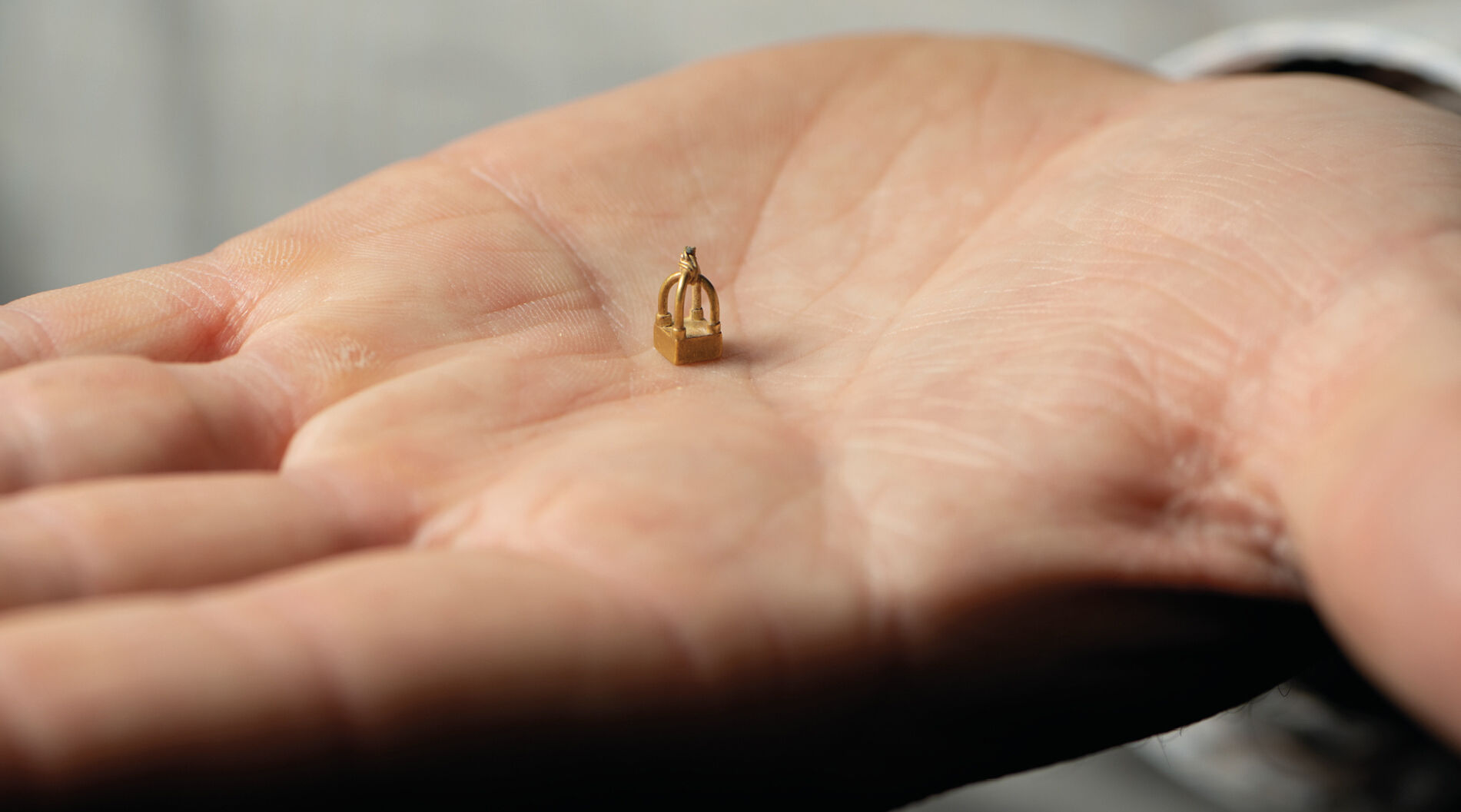“And Hiram King of Tyre sent his servants unto Solomon; for he had heard that they had anointed him king in the room of his father; for Hiram was ever a lover of David” (1 Kings 5:15).
The Bible relates that during the period of the united monarchy in the 10th century b.c.e., a close relationship developed between Israel and the Phoenicians, a people situated northwest of Jerusalem in a collection of city-states on the shores of the Mediterranean Sea. Immediately following David’s capture of Jerusalem around 1000 b.c.e., King Hiram of Tyre (a dominant city-state) sent Lebanon’s famed cedar wood, along with stonemasons and carpenters, to help Israel’s king construct a lavish palace in the northern part of the City of David (2 Samuel 5:11). 2 Samuel 24:7 even includes Tyre in the census David commissioned Joab to undertake near the end of his reign, suggesting that Tyre was an extremely close ally.
The friendship between Israel and Phoenicia continued after David’s death (2 Chronicles 2:2). 1 Kings 5 states that when Solomon was crowned, King Hiram sent a delegation to Jerusalem to congratulate the new king. Solomon later hired the Tyrians to supply cedar for the construction of the temple (2 Chronicles 2:7, 15). Along with the Phoenician builders, King Solomon also requested King Hiram supply cunning artificers and craftsmen skilled in metalworking and clothing manufacturing. These skilled Phoenician laborers worked in Jerusalem during the construction of Solomon’s new royal quarter on Jerusalem’s Ophel (an area located between the City of David to the south and the Temple Mount to the north).
The Bible records King Hiram’s description of one particular craftsman: “… He is trained to work in gold, silver, bronze, iron, stone, and wood, and in purple, blue, and crimson fabrics and fine linen, and to do all sorts of engraving and execute any design that may be assigned him, with your craftsmen, the craftsmen of my lord, David your father” (2 Chronicles 2:14; English Standard Version). The biblical account clearly reveals that numerous Phoenician representatives were in Jerusalem’s royal quarter during the 10th century b.c.e.
Now, thanks to the discovery of a uniquely Phoenician piece of jewelry on the Ophel, we have the best archaeological evidence to date of a 10th-century Phoenician presence in Jerusalem.
A Tale of Discovery
The renewed Hebrew University Institute of Archaeology Ophel excavations, directed by the late Dr. Eilat Mazar, began in 2009 and continued until her last excavation season in 2018. The area had previously been excavated in the 1970s by Eilat’s grandfather and former president of Hebrew University, Prof. Benjamin Mazar. Motivated by the encouragement of her grandfather, and thanks to the generous donations of Daniel Mintz and Meredith Berkman, Eilat was able to conduct multiple large-scale excavations on the Ophel, together with a large contingent of volunteers and students from Herbert W. Armstrong College in Edmond, Oklahoma.
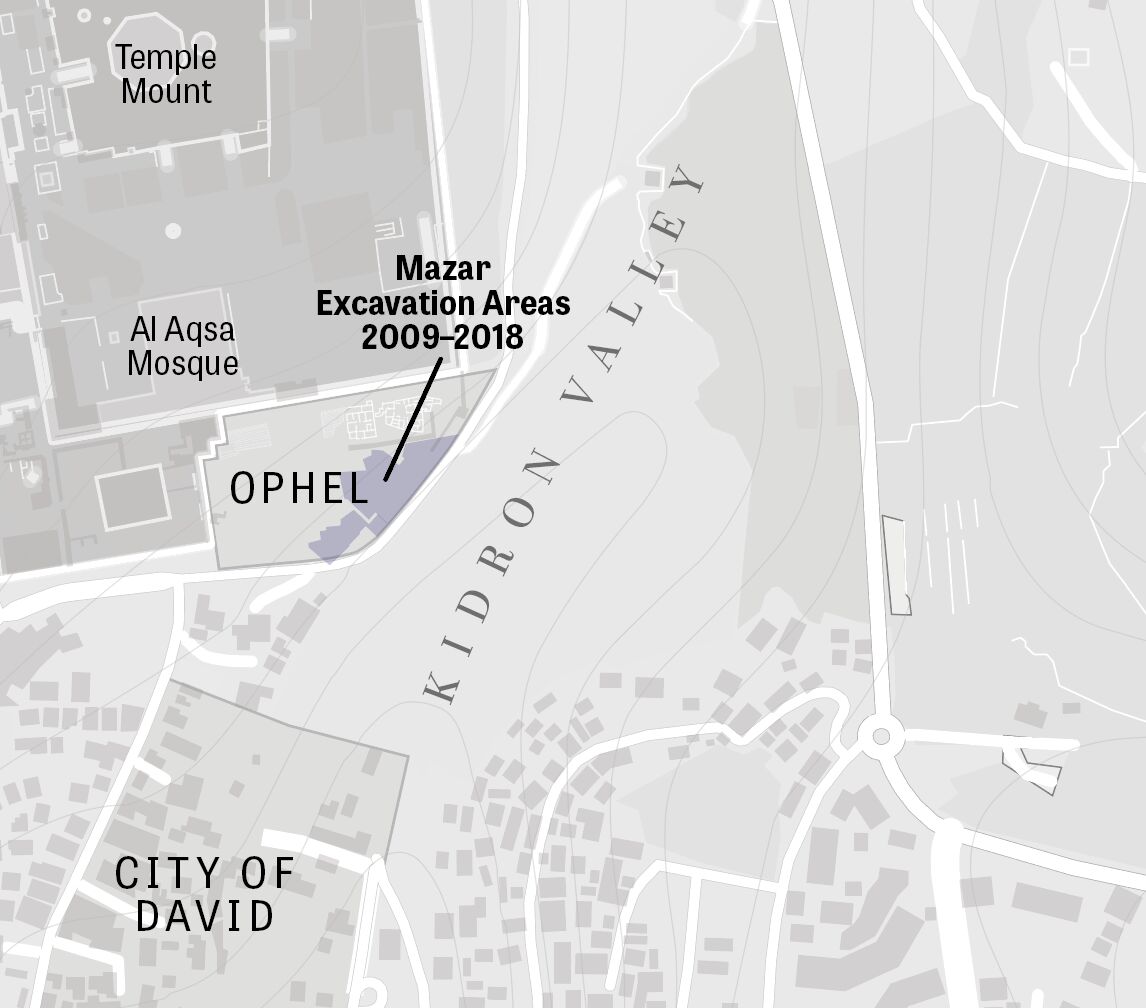
Monumental walls were discovered throughout the area, which Dr. Mazar dated to the 10th century b.c.e.—the time period that included King Solomon. Equally important were the numerous tiny artifacts discovered in the occupational layers. These finds would have been missed were it not for Eilat’s trailblazing use of wet sifting. (Wet sifting involves taking excavated earth, putting it through a sifter, and spraying it with water to wash away soil and reveal miniature objects that might otherwise have gone undetected.)
It’s an extremely labor-intensive process, but Eilat insisted that we wet sift all Iron Age material. This meticulous practice led to the discovery of the two oldest pieces of writing ever found in Jerusalem—cuneiform tablet fragments from the 14th and 13th centuries b.c.e.—as well as dozens of seals and seal impressions, the most notable being the bulla of King Hezekiah.
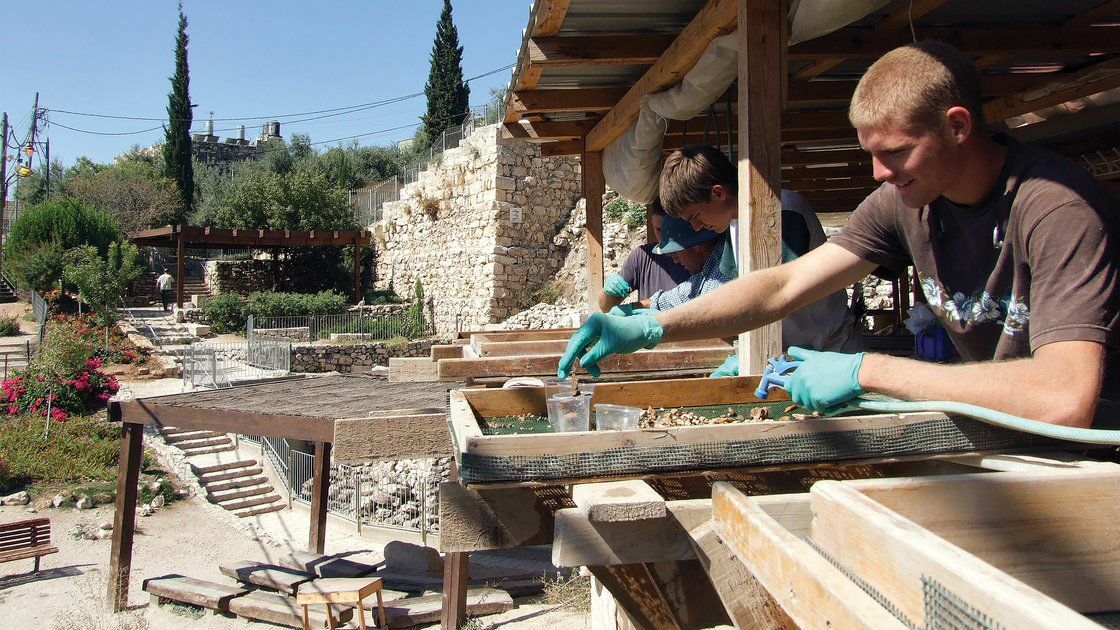
In the world of archaeology, it is not unusual for significant time to pass between the moment an artifact is dug from the ground and the moment it is finally studied and identified. On the Ophel dig, small artifacts discovered during wet sifting were documented, boxed up, and taken to the lab to be analyzed at a later time. In the case of Hezekiah’s seal impression, there was a five-year gap between when it was first taken from the ground and eventually identified and revealed to the public.
In this case, it was more than 10 years before we learned what we had excavated!
The Ophel Electrum Basket Pendant
During the 2012 excavation, which lasted five months, I was area supervisor (under Dr. Mazar) of Area B. The final two months were largely devoted to excavating early Iron iia walls, fills and floors. [The full stratigraphy study of Area B will be published by Dr. Ariel Winderbaum in the forthcoming Volume iii of The Ophel Excavations to the South of the Temple Mount, 2009–2013, directed by Eilat Mazar, Final Reports–Iron Age (Qedem).] The excavations were completed in conjunction with the National Parks Authority, East Jerusalem Development Fund and with the approval of the Israel Antiquities Authority.
Overseeing an area is a full-time job. The wet-sifting process occurs on-site but at a different location and by a different team, which makes it virtually impossible to keep abreast of the finds revealed through wet sifting. I had no idea that this exquisite gold object, smaller than a shekel, from Area B had been found in wet sifting. I didn’t learn about it until years later (after Dr. Mazar had died) when we began work on publishing the final reports of the excavation. Officially known as the “Ophel Electrum Basket Pendant,” the full publication of this object will be included in the aforementioned final report, coauthored by myself and Iron Age jewelry expert Dr. Amir Golani. It was also recently published in Hebrew in the City of David Studies of Ancient Jerusalem, Vol. 19.

I first came across the pendant in early 2023 while searching through some unpublished finds from Area B in Eilat Mazar’s office (which once belonged to Prof. Benjamin Mazar and is now a hub of activity as Eilat’s sister, Avital Mazar-Tsairi, oversees the important task of completing the remaining publications of Eilat’s excavations).
The pendant, with its intricate design and impressive golden luster, arrested my attention. Picking it up, I was struck by how heavy it was for such a tiny item.
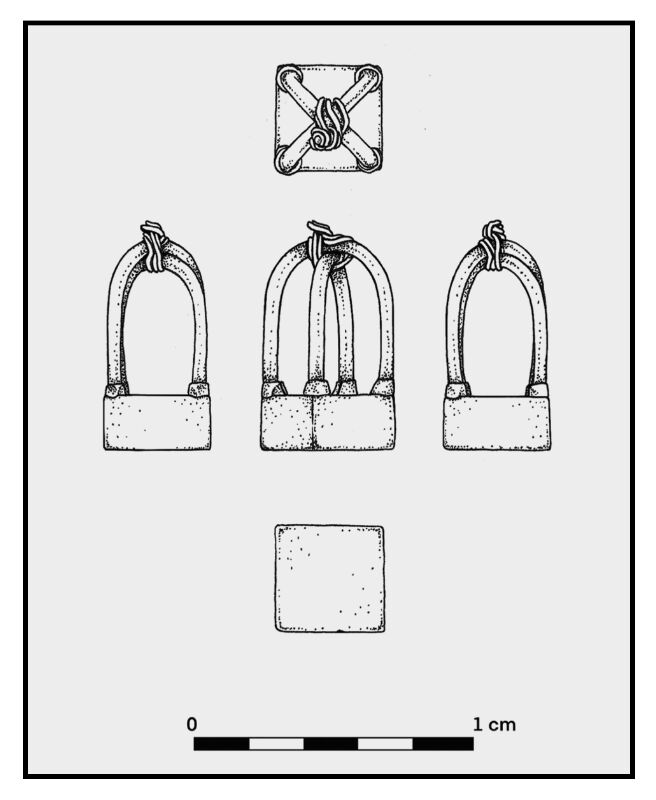
The base of the golden basket pendant jewelry piece is flat and solid, and measures 4 millimeters square with a height of 2 millimeters. Two parabolic wire handles measuring 0.5 millimeters in diameter spring crosswise from the upper corners of the basket and rise 6 millimeters above its top. The four joints between the corners of the basket and the parabolic wires are concealed by a short, seamless wire strip. A thin gold wire is tightly wrapped three times around the apex of the parabolic handles, creating a kind of knot that probably continued upward as a small loop (missing) that served to suspend the pendant. The wire was most likely produced through the strip-drawing method. In most such pendants, this suspension ring is usually attached to another small ring to form part of an earring hoop, which is missing. Most pendants of this type have a small protrusion, usually in the form of a small pyramid of minute metal spheres or granules, soldered on top of the basket. A close inspection of the top of the basket did not reveal indents or other traces of an attachment, which may have fallen off.
When we initially inspected the piece, no one in the office could identify the basket pendant for what it was. Based on its discovery context, the best we could do was label it as a stunning piece of jewelry from an early Iron iia context (typically associated with 10th-century b.c.e. Jerusalem). So this is what we did, and then we returned to our other work.

A couple of months later, on May 30, I decided to read Dr. Amir Golani’s 2013 definitive text, Jewelry From the Iron Age II Levant. I began to wonder: Did our Ophel jewelry piece have a parallel? The answer was on page 243, which identified a series of basket pendant earrings native to Phoenician sites found across the Mediterranean. There was only one “problem”: The Ophel pendant predated most of Dr. Golani’s basket pendants. Four of Golani’s examples were from Phoenician sites in Sardinia and dated to the seventh-to-sixth centuries b.c.e. Two were from Cyprus and dated to the same time period.
There were many more examples; all of which were found at exclusively Mediterranean sites directly connected to Phoenician settlement and colonization. They are also a highly personal object.
According to Dr. Golani, this made this type of pendant a clearly Phoenician “cultural marker.” They are a purely Phoenician phenomenon, found only where there was a physical Phoenician presence.
By this point, it was clear that this pendant was significant and that it needed to be studied much more deeply. Avital Mazar asked if I could complete the scientific report on the Ophel Basket Pendant.
The next step was to take the artifact to Prof. Naama Yahalom-Mack, excavator of the northern Israel site of Abel Beth Maacah and head of the metallurgy lab at the Institute of Archaeology at Hebrew University. We needed to study the metal composition of the pendant.
Scientific analysis showed that the pendant was made of electrum—an alloy of gold and silver, comprising Au 63±2%, Ag 32±2% and Cu 5±0.2%. Other elements—among them iron, silicon and lead—were present in trace amounts. Electrum is a harder metal than pure gold, providing greater durability for jewelry. This test confirmed that the Ophel Basket Pendant is one of the earliest “gold” artifacts ever discovered, to date, in an archaeological excavation in Jerusalem.
Next, I reached out to Iron Age jewelry expert Dr. Golani and asked for advice on to how proceed with the research and publication process. He was delighted to meet and discuss.
Dr. Golani was immediately struck by the craftsmanship. “This is really good craftsmanship,” he told me. “I mean, it is really good craftsmanship, in terms of the goldsmith’s work himself.” He then noted that it was indeed slightly different from the other later examples from Phoenician sites (shorter base cube, no pyramidal structure of granules, a higher level of craftsmanship in hiding joinery with gold strand). And yet it was also far more intricate in design than the earlier, bulkier examples found in the southern Levant.
Watching Dr. Golani inspect the item and then talk in detail about its exquisite design parallels though the Mediterranean world, I realized he needed to be involved in the research and publication of the pendant. If the pendant ended up being the earliest golden jewelry ever found in Jerusalem, one of Israel’s leading experts had to be involved. Dr. Golani was delighted by the proposal for a joint venture, and we teamed up.
The Symbolic Significance and Development of Basket Pendants
Given that there is no ancient text describing the symbolism or purpose of the pendant, we are left to comparative analysis with other pendants, as well the dating of the find spot, from which to make conclusions as to their purpose.
Throughout the Iron Age, the regularity and constant design of basket pendants, wherever they are found, naturally suggest a known symbolic significance and possibly even religious importance.
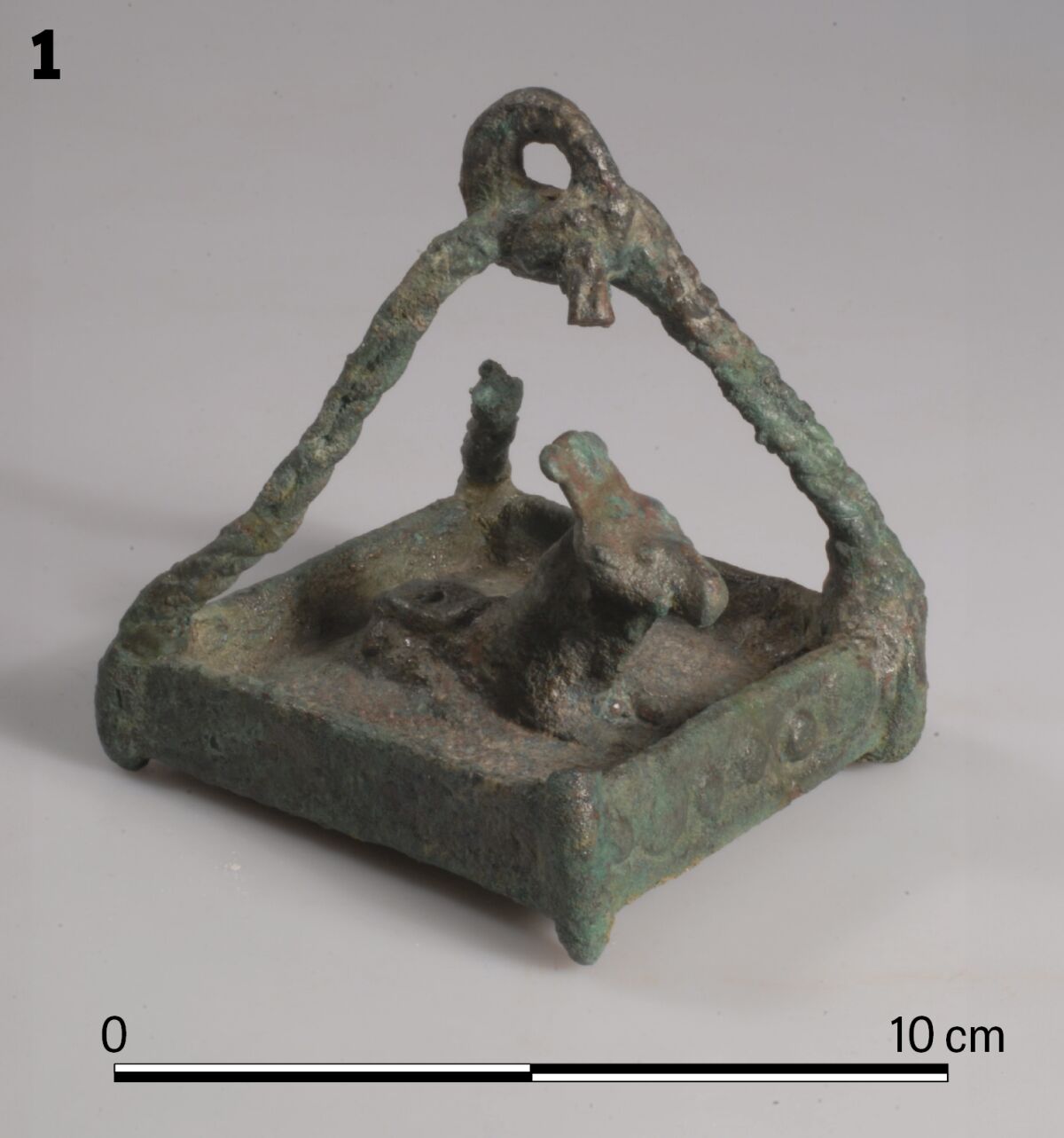
According to Golani, basket pendants may have been a miniature and schematic representation of another, larger object that was possibly well known to the creator’s culture. The basket with handles, capped by a suspension ring, suggests that this object may have been portable. Since the first appearance of basket pendants in the late Iron i (late 11th century b.c.e.) period was in the Southern Levant, their significance should be sought among the local cultural elements of that period. Perhaps the best example of comparison to a religious object is a copper alloy object discovered in excavations at Tel Beth Shean, directed by Hebrew University Prof. Amihai Mazar. Dated to the 12th century b.c.e., it depicts a flat square platform or shallow box decorated on its sides with circular medallions, from the four corners of which are depicted suspension ropes, ending in a small ring. On top of the platform is a crouching ram in a sphinx-like position and wearing an Egyptian-style Atef crown.
The depiction of the “handles” as ropes clearly suggests that this is a representation of another, possibly well-known object made of perishable materials (such as rope and possibly wood for the platform), of which no examples are known. Thus, it’s feasible that basket pendants are even more miniature representations and schematic representations of a portable shrine or altar.
Stylistically, in its general form and proportions, the 12th-century b.c.e. object from Tel Beth Shean is more similar to the Ophel Basket Pendant than to the more commonly known examples of the eighth to sixth centuries b.c.e. In contrast to the well-known examples from the second half of Iron Age ii, where the basket is shaped as a cube, both the Beth Shean model and the Ophel pendant show the basket as a low platform.
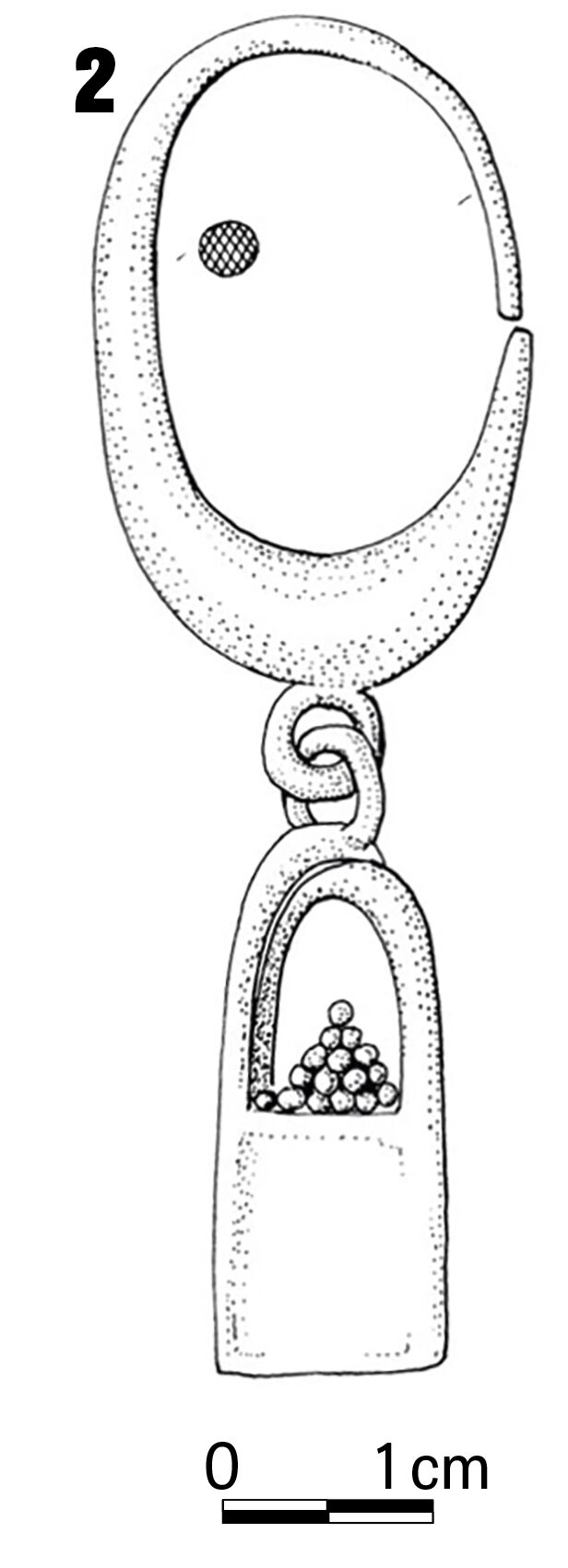
On the other hand, in general size and precision of design, the Ophel pendant is closer to the later Phoenician examples than to the bigger, clunkier antecedents found in southern Levant.
Thus, it is likely then that the miniaturized representation of the shrine in pendant form was adopted by the Phoenicians, who grew out of the Canaanite cultural milieu of the Iron Age i. Soon thereafter, the basket pendant was apparently worn as an earring pendant, and then later became widely popular among Phoenicians primarily during the late eighth to sixth centuries b.c.e. The widespread use of this form as a pendant representing a shrine may have been believed to provide protective powers for those who wore them and may have also served as an ethnic symbol or cultural marker, identifying their bearer as a Phoenician; in the same way that many today may wear a cross or a Star of David in order to identify themselves.
Jerusalem-Phoenician Connection
The discovery of the Phoenician-style pendant in a 10th-century b.c.e. context in Jerusalem illuminates the relationship between the united monarchy in Jerusalem and the Phoenicians, who occupied the Lebanese coast through the late second and into the first millennium b.c.e. and specialized in maritime trade. Outside the biblical text, the seafaring exploits of the Phoenicians are supported by the discovery of Phoenician colonies throughout the Mediterranean region from as early as the 10th century b.c.e. By the late eighth century b.c.e., the Phoenicians had firmly established many colonies in North Africa, Sardinia and Iberia, which correlates directly to the earliest discovery of basket pendants at those locations.
Archaeological evidence also shows that the Phoenician trade network (particularly in silver) between the western Mediterranean and the southern Levant was active during the 10th century b.c.e. The discovery of silver hoards at Dor and Akko, dated to the second half of the 10th century b.c.e. and the 10th to ninth centuries b.c.e. (respectively), which had been transported to the Phoenician/Israelite coast, have been shown to originate in western Mediterranean sites associated with the Phoenicians.
The discovery of 10th-century b.c.e. silver hoards in the southern Levant originating in the western Mediterranean is important in providing an archaeological baseline for Phoenician influence in this region. Interestingly, this dating also parallels the biblical text in terms of both the commodity of trade in silver and the 10th century b.c.e.
1 Kings 10:22 states: “For the king [Solomon] had at sea a navy of Tarshish with the navy of Hiram [of Tyre]; once every three years came the navy of Tarshish, bringing gold, and silver, ivory, and apes, and peacocks.” The Bible tells us that this relationship lasted from King David through King Solomon’s reign—or most of the 10th century b.c.e. In addition, though the Phoenicians are usually recognized for their role in maritime trade, their part in overland trade should not be overlooked. A growing body of evidence from the Iron Age ii shows Phoenician trade and traders at both inland and coastal sites throughout the southern Levant.
Until now, archaeological evidence of Phoenician involvement in Jerusalem during the 10th century has been relatively scant. Parts of three volute “Proto-Aeolic” capitals have been found in excavations on the eastern hill of Jerusalem, which have stylistic ties to the Phoenicians. However, two were found in secondary contexts and another in a collapse dating from the end of Iron Age ii.
In 2005, two small items linked to Phoenician trade were discovered by Dr. Eilat Mazar while excavating the Large Stone Structure at the summit of the City of David: 10-centimeter-long stylized ivory inlay consisting of two identical halves that would have adorned either side of an iron shaft, perhaps part of a knife or mirror. The ivory item was found alongside an elegant black-on-red Cypriot juglet in a late 10th-century context. According to Dr. Mazar, an identically designed inlay was discovered attached to a sword at the excavations of the Phoenician site of Achziv on the northern coast of Israel. The sword, alongside other funerary goods, is dated to the 10th century b.c.e.

In 2013, a seal of Cypriot origin was discovered in the Ophel excavations. The conical seal portrays a lion facing left and a schematic depiction of a human figure. Seals with this same motif are typical of Cyprus’s Cypro-Geometric i (circa 1050–950 b.c.e.). This period overlaps the beginning of the Phoenician presence and trade in Cyprus. Othmar Keel writes that these are “most certainly” an import from Cyprus, providing further evidence of an early relationship between areas of Phoenician influence and Jerusalem.
Now we can add the Ophel Electrum Basket Pendant to this list of objects attesting to Phoenicia’s connection to Iron Age Jerusalem.
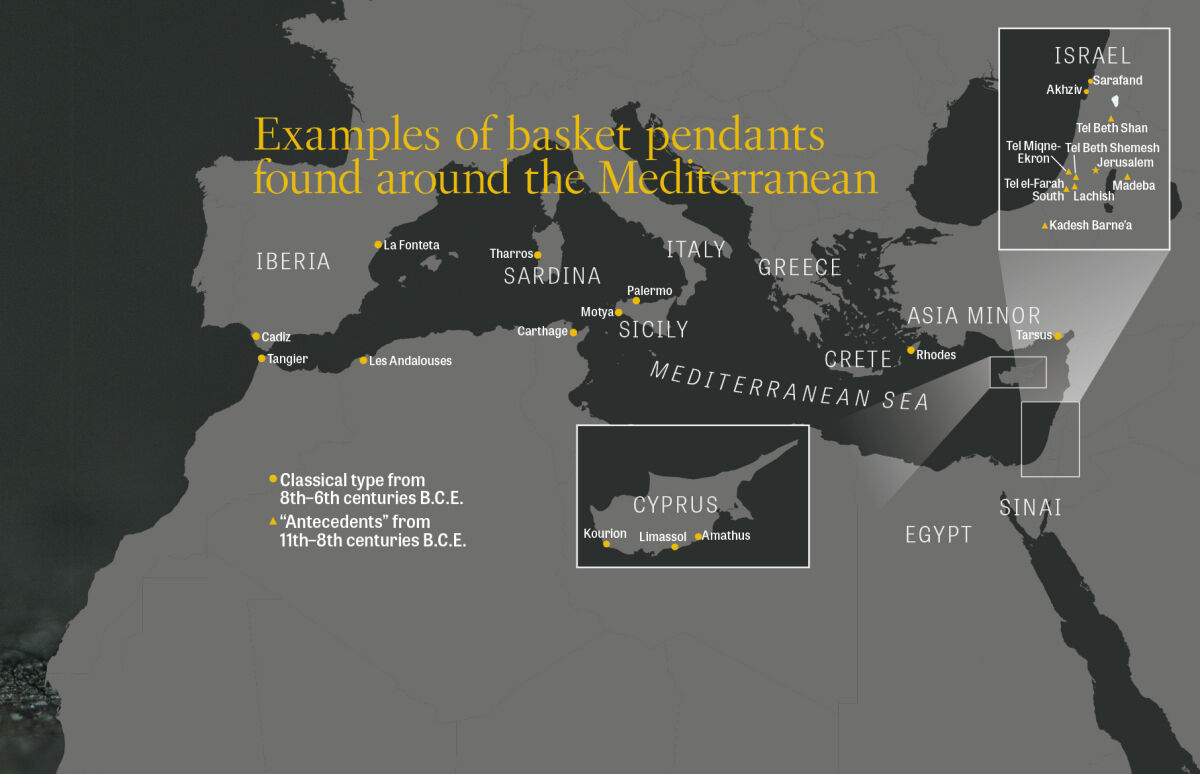
But this pendant may signify more than just an Israel-Phoenicia connection. Jewelry at this time is not just an object of aesthetic beauty. These objects are not mass-produced trinkets but require a high level of craftsmanship and were manufactured only on demand. When worn as an earring, in frontal display, a jewelry item transmits information about the wearer, just like a Star of David or cross would represent something about the bearer in modern times.
Accordingly, since these basket pendants are found at sites clearly associated with Phoenician settlement, these pendants may be seen as a cultural marker signifying the presence and identification of a Phoenician individual. Thus, when you find a Phoenician style basket pendant in Jerusalem, it’s the best indication yet that a Phoenician was literally on the scene in Jerusalem’s royal quarter.
When we pair the archaeological evidence with the Bible, this tiny artifact resurrects the biblical history of the golden age in ancient Israel. It recalls the time of the united monarchy, when Israel and Judah were unified under a single king ruling from Jerusalem. It tells of the time when Phoenicians of the Lebanese coast partnered with this king in his most important building projects in the capital city. 1 Kings 5:15 states, “And Hiram king of Tyre sent his servants unto Solomon; for he had heard that they had anointed him king in the room of his father; for Hiram was ever a lover of David.”
With assistance from Dr. Amir Golani
